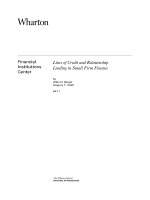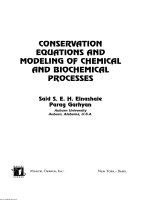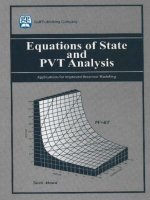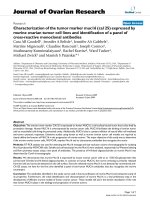Equations of lines and curves
Bạn đang xem bản rút gọn của tài liệu. Xem và tải ngay bản đầy đủ của tài liệu tại đây (53.67 KB, 5 trang )
Equations of Lines and Curves: Practice Problems and Solutions
Question 1.
Proof. The midpoint coordinates
are
(
) given by the average of the corresponding coordinates of A and B.
2+(−4) 3+1
Thus, the midpoint is
, 2 = (−1, 2).
quod
2
erat
dem■
Question 2. Determine the distance between the points P (3, −2) and Q(−1, 5).
√
Proof. The distance between two points P (x1 , y1 ) and Q(x2 , y2 ) is given by the formula (x2 − x1 )2 + (y2 − y1 )2 .
√
√
√
Therefore, the distance between P and Q is (−1 − 3)2 + (5 − (−2))2 = 64 + 49 = 113.
quod
erat
dem■
Question 3. Find the equation of the line passing through the points A(2, 4) and B(−1, −3).
Proof. The equation of a line passing through two points A(x1 , y1 ) and B(x2 , y2 ) is given by the formula
1
y − y1 = xy22 −y
(x − x1 ). Plugging in the values, we have y − 4 = −3−4
(x − 2). Simplifying, we get
−x1
−1−2
y = −x + 6.
quod
erat
dem■
Question 4. Determine the slope of the line passing through the points P (2, 5) and Q(−3, 1).
Proof. The slope of a line passing through two points P (x1 , y1 ) and Q(x2 , y2 ) is given by the formula
−y1
−4
1−5
m = xy22 −x
= −5
= 45 .
. Plugging in the values, we have m = −3−2
quod
1
erat
dem■
Question 5. Find the equation of the line parallel to the x-axis and passing through the point P (3, −2).
Proof. Since the line is parallel to the x-axis, its equation is of the form y = k, where k is a constant. Since
the line passes through P (3, −2), we have −2 = k, so the equation is y = −2.
quod
erat
dem■
Question 6. Find the equation of the line perpendicular to the y-axis and passing through the point
P (−4, 5).
Proof. Since the line is perpendicular to the y-axis, it is a vertical line with an undefined slope. Its equation
is of the form x = k, where k is a constant. Since the line passes through P (−4, 5), we have x = −4. quod
erat
dem■
Question 7. Determine the equation of the line perpendicular to the line y = 32 x + 2 and passing through
the point P (1, −4).
Proof. The given line has a slope of 32 . The slope of a line perpendicular to it is the negative reciprocal,
which is − 23 . Using the point-slope form, the equation of the perpendicular line passing through P (1, −4)
is y − (−4) = − 23 (x − 1). Simplifying, we get y = − 23 x − 10
.
quod
3
erat
dem■
Question 8. Find the coordinates of the intersection point of the lines y = 2x + 1 and y = −3x + 4.
Proof. To find the intersection point, we need to solve the system of equations formed by the two lines.
Equating the expressions for y, we have 2x+1 = −3x+4.
Solving this equation, we get x = 35 . Substituting
( )
this value back into either equation, we find y = 2 35 + 1 = 13
. Therefore, the intersection point is
5
(
3 13
,
5 5
)
.
quod
erat
dem■
1
2
Question 9. Determine the equation of the circle with center C(2, −1) and radius r = 4.
Proof. The equation of a circle with center (h, k) and radius r is given by (x − h)2 + (y − k)2 = r2 .
Substituting the given values, we have (x − 2)2 + (y − (−1))2 = 42 . Simplifying, we get (x − 2)2 + (y + 1)2 =
16.
quod
erat
dem■
Question 10. Find the distance between the point P (3, 2) and the line 2x − 3y + 5 = 0.
Proof. The distance between a point (x0 , y0 ) and a line Ax + By + C = 0 is given by the formula d =
|Ax√0 +By0 +C|
√
√2
. Plugging in the values, we have d = |2(3)−3(2)+5|
= |6−6+5|
= √513 .
quod
2
4+9
A2 +B 2
2 +(−3)
erat
dem■
Question 11. Determine the equation of the parabola with vertex V (2, −3) and focus F (2, −5).
1
Proof. The standard equation of a parabola with vertex (h, k) and focus (h, k − 4a
) is given by (x − h)2 =
4a(y − k). In this case, the vertex is V (2, −3) and the focus is F (2, −5). The value of h remains the same
for both the vertex and focus, so the equation becomes (x − 2)2 = 4a(y + 3).
To find the value of a, we can use the distance formula between the vertex and focus. The distance
1
1
between the vertex and focus is equal to 4a
, so we have 4a
= | − 5 − (−3)|.
Solving for a, we get a = 18 .
( )
Substituting this value back into the equation, we have (x − 2)2 = 4 81 (y + 3). Simplifying further, we
get (x − 2)2 = 21 (y + 3).
quod
erat
dem■
Question 12. Find the equation of the ellipse with center C(1, −2), major axis of length 10, and minor
axis of length 6.
Proof. The standard equation of an ellipse with center (h, k), major axis length 2a, and minor axis length
2
2
2b is given by (x−h)
+ (y−k)
= 1. In this case, the center is C(1, −2), the major axis length is 10, and the
a2
b2
minor axis length is 6.
2
The value of h and k are the same as the coordinates of the center, so the equation becomes (x−1)
+
a2
(y+2)2
= 1.
b2
To find the values of a and b, we can use the lengths of the major and minor axes. We have 2a = 10, so
a = 5, and 2b = 6, so b = 3.
2
(y+2)2
Substituting these values back into the equation, we have (x−1)
+
= 1.
quod
2
5
32
erat
dem■
Question 13. Find the equation of the hyperbola with center C(0, 0), transverse axis of length 8, and
conjugate axis of length 6.
Proof. The standard equation of a hyperbola with center (h, k), transverse axis length 2a, and conjugate
2
2
axis length 2b is given by xa2 − yb2 = 1. In this case, the center is C(0, 0), the transverse axis length is 8,
and the conjugate axis length is 6.
2
2
The value of h and k are the same as the coordinates of the center, so the equation becomes xa2 − yb2 = 1.
To find the values of a and b, we can use the lengths of the transverse and conjugate axes. We have
2a = 8, so a = 4, and 2b = 6, so b = 3.
2
2
Substituting these values back into the equation, we have x42 − y32 = 1.
quod
erat
dem■
3
Question 14. Find the equation of the circle with center C(−2, 3) and radius 5.
Proof. The standard equation of a circle with center (h, k) and radius r is given by (x − h)2 + (y − k)2 = r2 .
In this case, the center is C(−2, 3) and the radius is 5.
Substituting these values into the equation, we have (x + 2)2 + (y − 3)2 = 52 , which simplifies to
(x + 2)2 + (y − 3)2 = 25.
quod
erat
dem■
Question 15. Find the equation of the line passing through the points P (2, 5) and Q(−3, −1).
Proof. The equation of a line passing through two points (x1 , y1 ) and (x2 , y2 ) can be found using the
−y1
(x − x1 ).
point-slope form: y − y1 = xy22 −x
1
In this case, the points are P (2, 5) and Q(−3, −1). Substituting the values into the equation, we have
y − 5 = −1−5
(x − 2).
−3−2
(x − 2), which becomes y − 5 = 65 (2 − x).
Simplifying further, we get y − 5 = −6
−5
Expanding and rearranging, we have y − 5 = 12
− 65 x, which simplifies to y = 65 x + 15 .
quod
5
erat
dem■
Question 16. Find the equation of the line perpendicular to the line 3x + 4y = 7 and passing through
the point P (2, −1).
Proof. The given line has the form Ax + By = C, where A = 3, B = 4, and C = 7. To find the
perpendicular line, we need to swap the coefficients A and B and change the sign of one of them. So, the
equation of the perpendicular line will be 4x − 3y = D.
To find the value of D, we can substitute the coordinates of point P (2, −1) into the equation. We have
4(2) − 3(−1) = D, which simplifies to 8 + 3 = D. Therefore, D = 11.
The equation of the perpendicular line is 4x − 3y = 11.
quod
erat
dem■
Question 17. Find the equation of the line parallel to the line 2x − 5y = 3 and passing through the point
P (−1, 4).
Proof. The given line has the form Ax + By = C, where A = 2, B = −5, and C = 3. To find a parallel
line, we need to keep the coefficients A and B unchanged. So, the equation of the parallel line will also be
2x − 5y = D.
To find the value of D, we can substitute the coordinates of point P (−1, 4) into the equation. We have
2(−1) − 5(4) = D, which simplifies to −2 − 20 = D. Therefore, D = −22.
The equation of the parallel line is 2x − 5y = −22.
quod
erat
dem■
Question 18. Find the equation of the line passing through the points P (3, 2) and Q(−2, 6).
Proof. The equation of a line passing through two points (x1 , y1 ) and (x2 , y2 ) can be found using the
−y1
point-slope form: y − y1 = xy22 −x
(x − x1 ).
1
In this case, the points are P (3, 2) and Q(−2, 6). Substituting the values into the equation, we have
6−2
y − 2 = −2−3
(x − 3).
4
Simplifying further, we get y − 2 = −5
(x − 3), which becomes y − 2 = − 45 (3 − x).
, which simplifies to y = − 54 x + 22
.
Expanding and rearranging, we have y − 2 = − 45 x + 12
quod
5
5
erat
dem■
4
Question 19. Find the equation of the line perpendicular to the line y = 23 x + 4 and passing through the
point P (2, −1).
Proof. The given line is in slope-intercept form y = mx + b, where m = 32 is the slope. The perpendicular
line will have a slope that is the negative reciprocal of 32 . So, the slope of the perpendicular line is − 23 .
Using the point-slope form, we have y − (−1) = − 23 (x − 2). Simplifying further, we get y + 1 = − 23 x + 43 .
Rearranging the equation, we have y = − 23 x + 13 .
quod
erat
dem■
Question 20. Find the equation of the line parallel to the line y = 2x − 3 and passing through the point
P (4, 5).
Proof. The given line is in slope-intercept form y = mx + b, where m = 2 is the slope. To find a parallel
line, we need to keep the slope unchanged. So, the equation of the parallel line will also be y = 2x + c.
To find the value of c, we can substitute the coordinates of point P (4, 5) into the equation. We have
5 = 2(4) + c, which simplifies to 5 = 8 + c. Therefore, c = −3.
The equation of the parallel line is y = 2x − 3.
quod
erat
dem■
Question 21. Find the equation of the line passing through the points P (1, 2) and Q(3, 6).
Proof. The equation of a line passing through two points (x1 , y1 ) and (x2 , y2 ) can be found using the
−y1
(x − x1 ).
point-slope form: y − y1 = xy22 −x
1
In this case, the points are P (1, 2) and Q(3, 6). Substituting the values into the equation, we have
y − 2 = 6−2
(x − 1).
3−1
Simplifying further, we get y − 2 = 42 (x − 1), which becomes y − 2 = 2(x − 1).
Expanding and rearranging, we have y − 2 = 2x − 2, which simplifies to y = 2x.
quod
erat
dem■
Question 22. Find the equation of the line perpendicular to the line 4x − 5y = 7 and passing through
the point P (2, −1).
Proof. The given line has the form Ax + By = C, where A = 4, B = −5, and C = 7. To find a
perpendicular line, we need to swap the coefficients A and B and change the sign of one of them. So, the
equation of the perpendicular line will be −5x − 4y = D.
To find the value of D, we can substitute the coordinates of point P (2, −1) into the equation. We have
−5(2) − 4(−1) = D, which simplifies to −10 + 4 = D. Therefore, D = −6.
The equation of the perpendicular line is −5x − 4y = −6.
quod
erat
dem■
Question 23. Find the equation of the line parallel to the line 3x + 2y = 5 and passing through the point
P (−1, 4).
Proof. The given line has the form Ax + By = C, where A = 3, B = 2, and C = 5. To find a parallel
line, we need to keep the coefficients A and B unchanged. So, the equation of the parallel line will also be
3x + 2y = D.
To find the value of D, we can substitute the coordinates of point P (−1, 4) into the equation. We have
3(−1) + 2(4) = D, which simplifies to −3 + 8 = D. Therefore, D = 5.
The equation of the parallel line is 3x + 2y = 5.
quod
erat
dem■
5
Question 24. Find the equation of the line passing through the points P (−2, 3) and Q(4, −1).
Proof. The equation of a line passing through two points (x1 , y1 ) and (x2 , y2 ) can be found using the
−y1
point-slope form: y − y1 = xy22 −x
(x − x1 ).
1
In this case, the points are P (−2, 3) and Q(4, −1). Substituting the values into the equation, we have
−1−3
y − 3 = 4−(−2)
(x − (−2)).
Simplifying further, we get y − 3 = −4
(x + 2), which becomes y − 3 = − 23 (x + 2).
6
Expanding and rearranging, we have y − 3 = − 23 x − 43 , which simplifies to y = − 32 x + 53 .
quod
erat
dem■
Mathematics









